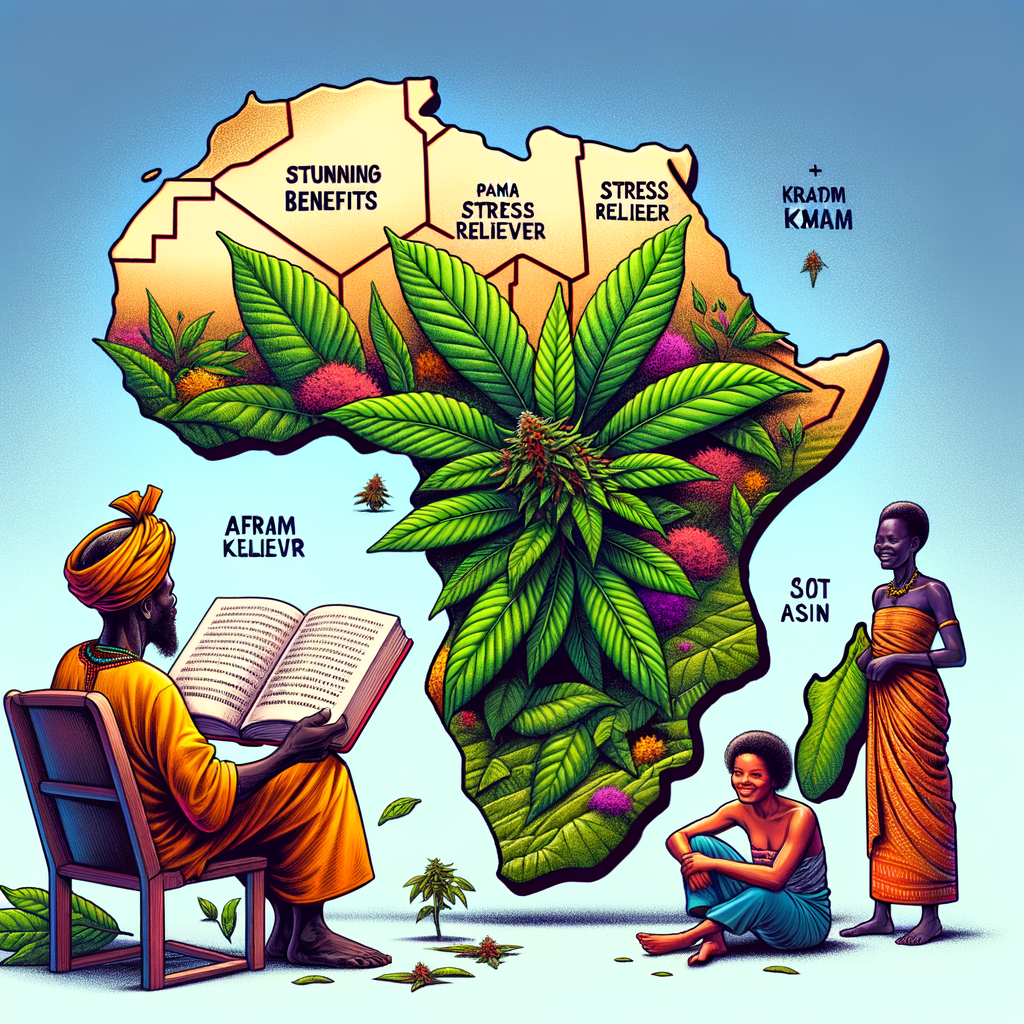
Kratom in Africa: Stunning Benefits You Can’t Ignore
- What is Kratom and Where Does it Come From?
- Understanding the Benefits of Kratom
- 1. Pain Relief
- 2. Enhanced Mood
- 3. Increased Energy
- 4. Better Sleep
- How to Use Kratom Safely
- Recommended Dosages
- Choose the Right Strain
- Avoid Mixing
- The Growing Presence of Kratom in Africa
- Cultivation in Africa
- Economic Opportunities
- Challenges and Regulations
- Kratom and Traditional Medicine
- Integrating Kratom
- Collaborative Research
- Myths and Misconceptions Surrounding Kratom
- Kratom Equals Opioid Addiction
- Legal Grey Area
- How to Select Quality Kratom
- Research Vendors
- Check Customer Reviews
- Observe the Appearance
- The Future of Kratom in Africa
- Potential Research Opportunities
- Regulatory Developments
- Economic Impact
- Conclusion: Embracing Kratom with Caution
- Final Thoughts
- Frequently Asked Questions
- References
What is Kratom and Where Does it Come From?

Kratom, scientifically known as Mitragyna speciosa, is a tropical evergreen tree native to Southeast Asia. While it’s popular in various parts of the world, it’s essential to recognize its origins. Farmers harvest the leaves from these trees, which are then used for their potential medicinal properties. Traditionally used for pain relief, Kratom has gained traction not only in Asia but also globally, including Africa.
In Africa, farmers are beginning to cultivate Kratom, looking to meet increasing demand. The leaves contain alkaloids that may promote a variety of effects, ranging from pain relief to mood enhancement. In fact, countries like South Africa and Zimbabwe are exploring the potential of this remarkable plant. Understanding its origins helps appreciate its benefits more deeply.
Understanding the Benefits of Kratom
Kratom users often report a range of positive effects. These can vary depending on the strain, dosage, and individual body chemistry. Below are some key benefits associated with Kratom:
1. Pain Relief
One of the primary reasons people turn to Kratom is for pain relief. Many users say that it works similarly to opioids but without the same level of addiction risk. The alkaloids interact with opioid receptors in the brain, helping to alleviate pain. This is particularly useful for those with chronic conditions who seek alternatives to pharmaceuticals.
2. Enhanced Mood
Kratom may help improve mood and increase motivation. Users often report feelings of euphoria, making it appealing to those dealing with anxiety or depression. This effect can help enhance social interactions and boost overall mental well-being.
3. Increased Energy
Some strains of Kratom can act as stimulants, providing users with an energy boost. This can be particularly useful for those needing an extra kick during long work days or vigorous workouts. The increased focus and stamina can lead to improved productivity.
4. Better Sleep
On the flip side, certain strains can also promote relaxation and help with sleep. Users have reported that Kratom helps them fall asleep faster and experience deeper rest. This can be beneficial for those struggling with insomnia or frequent sleep disturbances.
How to Use Kratom Safely
Using Kratom can be beneficial, but it’s essential to proceed with caution. Safety should always come first.
Recommended Dosages
When starting out, it’s best to begin with low dosages. Here’s a quick guide:
| Dosage Range | Effect |
|————–|————–|
| 1-5 grams | Mild effects |
| 5-15 grams | Moderate effects |
| 15-30 grams | Strong effects |
Always adjust based on your personal tolerance and experience. It’s crucial to listen to your body.
Choose the Right Strain
Different Kratom strains have varied effects. Some popular strains include:
– Maeng Da: Known for its high potency and energy-boosting qualities.
– Bali: Valued for its calming and pain-relieving effects.
– Green Malay: Offers a balance of energy and relaxation.
Selecting the appropriate strain can significantly affect your experience. Researching and possibly consulting with a knowledgeable vendor is advisable.
Avoid Mixing
Kratom should not be mixed with other substances, particularly alcohol or prescription medications. This combination can lead to adverse effects, including respiratory issues. Always use Kratom in moderation.
The Growing Presence of Kratom in Africa
Kratom’s popularity isn’t limited to Southeast Asia; it has started to make waves in Africa. The market for this plant is growing, and several African nations are beginning to embrace its benefits.
Cultivation in Africa
Countries like South Africa have recognized the potential of Kratom cultivation. Farmers are experimenting with growing different strains tailored to local climates. This shift can allow local farmers to benefit economically while also supplying an increasing demand.
Economic Opportunities
The Kratom market can offer job creation and sustainable income for farmers. As knowledge about Kratom spreads, more entrepreneurs are getting involved. This rising interest can contribute to local economies, creating a ripple effect throughout communities.
Challenges and Regulations
Despite its advantages, there are challenges to cultivating Kratom in Africa. Regulatory frameworks are often unclear, and many countries are still assessing its legitimacy. Farmers may face difficulties regarding quality control and distribution. Understanding local laws can be crucial for those interested in getting into this market.
Kratom and Traditional Medicine
In many cultures, herbal remedies play a vital role in healthcare. Kratom has been a part of traditional medicine in Southeast Asia, and its influence is beginning to extend to Africa.
Integrating Kratom
Some African cultures may integrate Kratom into their traditional healing practices. This could involve using Kratom alongside other herbal treatments. As scientific research supports its potential benefits, acceptance may grow.
Collaborative Research
Cooperative studies between African nations could enhance understanding of Kratom. Scientists can explore its applications, benefits, and risks more thoroughly. This research could lead to informed decisions regarding cultivation, usage, and regulation.
Myths and Misconceptions Surrounding Kratom
Like any natural remedy, Kratom comes with its share of myths and misconceptions. It’s essential to separate fact from fiction.
Kratom Equals Opioid Addiction
Many fear that using Kratom can lead to opioid addiction. While Kratom interacts with the same receptors, studies show that it may not carry the same risks as traditional opioids when used responsibly. Education on safe usage can help mitigate this perception.
Legal Grey Area
Kratom’s legal status varies worldwide. In some African nations, it may be legal for medical use. In others, strict regulations may apply. Researching local laws before purchasing or using Kratom is crucial to avoid legal issues.
How to Select Quality Kratom
Not all Kratom is created equal. Quality can vary significantly between vendors. Here are a few tips to ensure you’re choosing the best product.
Research Vendors
Take the time to research vendors before purchasing Kratom. Look for those who offer third-party testing. This testing ensures that the product is free from contaminants and accurately labeled.
Check Customer Reviews
Customer reviews can provide insight into product quality. Reliable vendors usually have positive feedback from previous users. Pay attention to complaints or reports of adverse effects, and weigh them against positive experiences.
Observe the Appearance
Quality Kratom leaves should appear vibrant and green. Dull or brownish leaves may indicate poor quality or improper storage. Evaluating the product visually can provide hints about its potency.
The Future of Kratom in Africa
Kratom’s role in African countries is evolving. While it carries potential benefits, challenges remain. How African nations approach Kratom will shape its future.
Potential Research Opportunities
As awareness of Kratom grows, so does interest in research. Collaborative studies could lead to a better understanding of the plant’s properties.
Regulatory Developments
Laws governing Kratom may change as more nations evaluate its merits. Advocacy may lead to clearer regulations, enabling safer use and cultivation.
Economic Impact
The economic benefits could prompt broader interest in Kratom farming. New markets may emerge, giving local farmers a chance to thrive. This trend could lead to a restructured perception of herbal medicine, placing emphasis on local resources.
Conclusion: Embracing Kratom with Caution
Kratom has potential benefits that are hard to ignore. Pain relief, mood enhancement, and increased energy are just a few. However, as with any substance, caution is essential. Researching and understanding its effects can lead to more informed choices.
Final Thoughts
If you’re considering incorporating Kratom into your wellness routine, start with caution. Begin with a low dose, choose high-quality products, and pay attention to how your body reacts. As Kratom gains traction in Africa, it may pave the way for new economic and medicinal opportunities.
Frequently Asked Questions
1. Is Kratom legal in all African countries?
– No, its legality varies by country. Always check local laws before use.
2. Can Kratom be addictive?
– While it interacts with opioid receptors, many users report low addiction risk when used responsibly.
3. What are the side effects of Kratom?
– Common side effects can include nausea, dizziness, and constipation. Always monitor your response to it.
4. How do I store Kratom?
– Store it in a cool, dry place, away from direct sunlight, to preserve its potency.
5. Can I mix Kratom with other substances?
– It is not advisable to mix Kratom with other drugs or alcohol, as it can lead to adverse effects.
6. What is the best time to take Kratom?
– Timing depends on the desired effect. Early doses may increase energy, while evening doses can promote relaxation.
7. Are there any communities focused on Kratom in Africa?
– Yes, social media and online forums have communities discussing Kratom usage and cultivation.
8. How can I find reputable Kratom vendors?
– Look for vendors who provide third-party testing and have positive customer reviews online.
9. Does Kratom have any age restrictions?
– Most vendors recommend that users be at least 18 years old due to safety concerns.
10. Are there different kratom strains unique to Africa?
– As cultivation expands in Africa, unique strains may develop, although most strains currently come from Southeast Asia.
References
1. Healthline: Kratom
2. WebMD: Kratom Overview
3. NPR: The Surprisingly Complicated Status of Kratom
4. FDA: Kratom Safety
5. Kratom Insider: Understanding Kratom Cultivation


